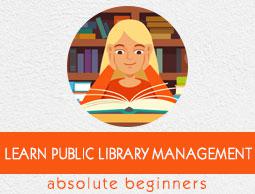Public Library Management - Overview
Libraries came into being to serve the poor people who could not afford to buy expensive reading material, and for researchers who needed special reference material for their studies. However, a library is more than just a center for getting access to your favorite books, journals, and magazines. Public libraries hold a vast and organized collection of printed or electronic reading material that can be delivered to a defined set of recipients by the library staff.
Libraries in general provide a range of services from preservation, collection, circulation, organization, and retrieval of information, which is either in printed or digital format. As public libraries became a popular place to gain and share knowledge, Public Library Management emerged as a separate discipline. In this tutorial, we will learn how public libraries are managed.
What is a Public Library?
A public library provides information and basic allied services to the general public. It is an organization that is established, financed, and supported by the community, either through local, regional, or national government or through some other organization.

Public libraries are operated by paid staff and provides all basic support required while delivering the knowledge resource in the form of a variety of media to the public. It serves access to knowledge and information through a wide array of resources and services.
The knowledge and information at the public library are equally available to all its members irrespective of their race, nationality, age, gender, religion, language, disability, or economic and employment status.
Traditional Libraries
Traditional libraries keep the printed knowledge resources, require users to be physically present to avail them, and the staff to handle and shelf the tangible knowledge resources.
Academic Library − It aids college and university students, and the staff and faculty. The institutions with large strength of students and staff can have their own libraries set up inside the campus. These libraries are organized on the basis of subjects.
Public Library − It serves the general public of all demographics. These libraries have different departments for toddlers, children, teens, and adults.
School or College Library − It is provided in the school or college premises. It serves the students of all grades starting from kindergarten to the highest grade offered by the school.
Special Library − It is located at corporate offices, private businesses, President’s house, old-age homes, orphanages, law firms, and the government. It targets a particular set of population in specialized environment.
New-Age Libraries
In today’s world of Internet communication, the readers can find their desired information in a few clicks. They don’t necessarily have to visit the library premises to avail or change the knowledge resources. Libraries now provide various kinds of library services, taking advantage of the advancement of technology.
Digital Library
It is very precisely the library that contains all knowledge resources stored in digital format. For example, a library of pdf or ePub format books and magazines, music collection of type MP3/MP4, or documentary archives collection of .mov/.avi files. This library is also equipped with the tools to retrieve desired digital information from the vast pool.
For example, the most well-known digital libraries today are YouTube, iTunes for Apple, Vudu, Google Play that provide a large collection of video information that user can download from.
E-Library
An e-library maintains a collection of various knowledge resources stored in analog format (such as tapes or cassettes or gramophone disks) as well as digital format such as CDs, DVDs, or Hard Disks. This term is less preferred in the domain of today’s libraries, as the format of storing and retrieving information is prominently turning into only digital.
Virtual Library
A virtual library is a collection of knowledge resources available on one or more computers. In such a library, the entire collection is stored at a location and an entry point to the collections is provided from every computer connected to it. The users are not aware of the physical location of the knowledge resources but they can access it.
Five Laws of Library Science
In 1931, Dr. S. R. Ranganathan, an Indian librarian proposed five laws of Library Science. They are as follows −
Books are for use − The books should be used for knowledge enhancement and wisdom more than just preserving them.
Every reader his/her book − Every subscriber of the public library should be able to get the knowledge element of his/her interest.
Every book its reader − Each knowledge element in the public library has its corresponding reader.
Save time of the reader − The time required for accessing, preserving, organizing, and circulating the knowledge element shall be minimum.
The library is a growing organism − This law suggests that the library has to keep on increasing with respect to its physical space, knowledge element, and readership.



